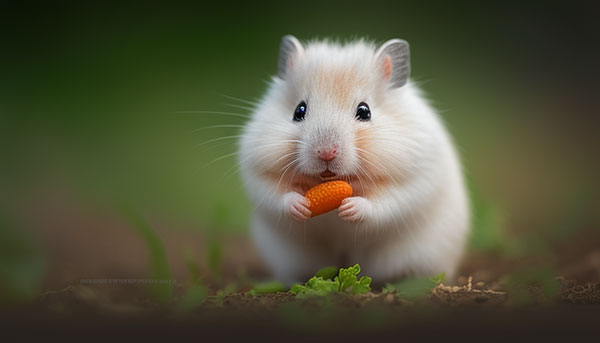How To Tell If Your Hamster Is Happy: A Guide To Understanding Your Hamster’s Mood
Knowing if your hamster is happy can help you provide the best care possible. And this will ensure that your pet remains healthy and content.
But how to tell if your hamster is happy? Examine your hamster’s behavior, body language, and overall health to see if it is content. A happy hamster will be active, playful, and have a healthy body with a clean and shiny coat. A happy hamster also has bright, clear eyes and a healthy appetite.
Continue reading to learn about the common indicators of a happy and unhappy hamster and how to offer your pet a comfortable and healthy environment.
How To Tell If Your Hamster Is Happy
Like any pet, you should ensure that your hamster is happy and healthy. Here is how to tell if your hamster is happy based on behavioral, physical, and environmental signs,

1. Behavioral Signs
You can tell if your hamster is happy using the following behavioral signs.
Activity Level
The degree of activity in your hamster is one of the most visible signals that it is content. Hamsters are naturally active creatures who enjoy running, playing, and exploring their surroundings. If your hamster is satisfied, it will be energetic and enthusiastic.
Playfulness
Playfulness is another clue that your hamster is content. Hamsters enjoy playing, and a satisfied hamster will be lively and inquisitive. If you find your hamster is more engaged in playing than usual, this is a positive indication that it is happy.

Groomed Appearance
Another clue that your hamster is content is a well-groomed appearance. Hamsters are fastidious creatures who enjoy keeping themselves clean. If your hamster is happy, you’ll notice that it grooms itself regularly.
Socialization And friendliness
Happy hamsters are frequently pleasant and gregarious and may approach you for pets and goodies. It’s a good indicator if your hamster is friendly and open to interaction.
Vocalizations
Although hamsters are generally not noisy animals, they make several sounds indicating happiness. A happy hamster, for example, may purr or produce a quiet chirping sound. If your hamster makes these noises, it’s a positive sign that it’s happy and content.
2. Physical Signs
The other sign to tell if your hamster is happy is observing physical signs like the ones below.
Healthy Appetite
A healthy appetite is another indication that your hamster is content. If your hamster is eating and drinking usually, it indicates that it is happy and healthy. But if your hamster isn’t eating or drinking, it could be a clue that it’s not feeling well.

Good Physical Condition
Another symptom of a happy hamster is good body condition. A healthy hamster has a round, plump tummy and strong legs. If your hamster is emaciated or has a sunken belly, it could be a sign that it is ill.
Bright, Clear Eyes
Another indicator that your hamster is happy and healthy is bright, clear eyes. If your hamster’s eyes are dull or foggy, it could indicate that it isn’t feeling well.
Healthy Coat
A healthy coat is another indication that your hamster is happy. A contented hamster has a lustrous, smooth coat free of mats and tangles. If your hamster’s coat is dull or matted, it could indicate it isn’t feeling well.
3. Environmental Signs
Here is how you can tell your hamster is happy using environmental signs.
Exercise
Hamsters require a lot of exercise, and a happy hamster usually exercises with the wheel you gave or with other sorts of physical activity. Exercise keeps your hamster physically and psychologically healthy.

Interaction With You
Hamsters are very social animals who thrive on interaction with their owners. A happy hamster enjoys spending time with you, playing with toys, and exploring its surroundings. If your hamster appears uninterested in engaging with you, it could be a sign that it is ill or stressed.
How To Tell If Your Hamster Is Unhappy
Hamsters are usually happy and playful creatures, but they will exhibit particular signs of unhappiness if they do not feel well. Awareness of these signals is critical to ensure your hamster’s health and happiness. Here are some of the key indicators that your hamster is feeling stressed or unhappy:

1. Biting Their Cage
When hamsters are stressed, bored, or frustrated, they may bite their cage. This behavior indicates that your hamster requires more excitement and interaction and a larger cage or toys.
2. Cage Aggression
It may be agitated or uncomfortable if your hamster becomes violent or bites when you try to handle or clean its cage. This behavior can also signify illness or an underlying health issue.
3. Always On Their Sandbox
If your hamster spends most of its time hiding in its sandbox, it may be agitated or terrified. Hamsters use their sandboxes as a place to retreat and feel safe, so if your hamster spends excessive time there, it may be a sign of stress or unhappiness.
4. Lethargy
If your hamster isn’t as active or lively as usual, it could be tired or sick. When a hamster is unhappy, it may sleep more than usual and show no interest in playing or exploring its cage.
5. Pacing
If your hamster is pacing back and forth in its cage, it could express stress or frustration. Pacing indicates that your hamster is not receiving enough exercise or stimulation and may want more toys or a larger cage.
What To Do If Your Hamster Is Unhappy
If you suspect your hamster is worried or unhappy, you may do a few things to help it feel better. Here are some suggestions for making your hamster feel more at ease and content:

- Extend the size of the cage: Your hamster may feel confined and stressed if its cage is too tiny. You may give your hamster more area to move around and play by giving it a larger cage, which can help reduce stress levels.
- Clean its cage regularly: Maintaining a clean and waste-free cage for your hamster will help reduce stress and enhance overall health. Keep the cage clean by regularly removing any uneaten food, filthy bedding, or other debris.
- Provide regular playtime: Spending time with and playing with your hamster can help reduce stress and improve its overall well-being. Spend a few minutes each day socializing with your hamster, whether playing with toys, exploring its cage, or simply cuddling.
- Increase the number of toys and activities: Hamsters enjoy playing and exploring, so provide plenty of toys and activities to keep your hamster occupied. Chew toys, climbing structures, tunnels, and exercise wheels are examples of such items.
Here is a video to show you how to make your hamster happy.
FAQs
Here are a few more related questions you may be asking.
Q1: How much attention do hamsters need?
Hamsters are relatively low-maintenance pets, but they do require some attention. Ideally, you should spend a few minutes each day interacting with your hamster by playing with it or simply watching it.
Q2: How do I know if my hamster likes his cage?
A happy hamster will be active, exploring its environment and playing with its toys. If your hamster appears lethargic, hides frequently, or spends most of its time in the bottom of its cage, it may be unhappy with its living conditions.
Q3: Is my hamster bored?
A bored hamster may exhibit restlessness, such as pacing, scaling its cage, or digging in its sandbox incessantly. To keep your hamster entertained, supply it with various toys and activities, including exercise wheels, chew toys, and climbing towers.
Conclusion
A happy hamster is an active, playful, well-groomed pet with a healthy appetite and good physical shape. Thus, a happy one has bright, clear eyes and a healthy coat. To keep your hamster happy, give it a clean and comfortable living area, proper temperatures, exercise opportunities, and interaction with you.
Now that you know how to tell if your hamster is happy, you can guarantee it has its best life by noticing signals that it is happy and healthy and those that are not.




